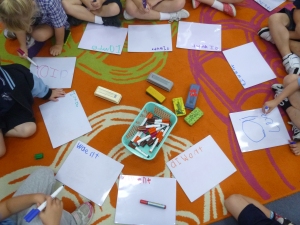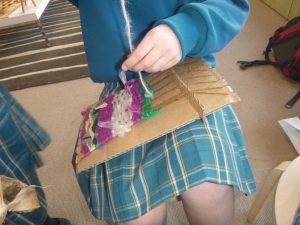I believe that I have met the criteria of standard 1.5 Differentiate teaching to meet the specific learning needs of students across the full range of abilities by doing the following:
- Click on the following link to view evidence of my teaching within the Arts classrooms.
- In a diverse year 4/5 class, I assessed students throughout the unit of Maths in a range of ways using predominately formative strategies. The strategies I used had a focus on students being actively involved. They responded after each lesson with thumbs up, to the side or down depending on level of understanding. Students reflected on their learning after most lessons and recorded in their maths books, if/how their thinking changed. I took notes on student progress and adjusted learning based on understanding. Below is a excerpt of a page from my notebook used for keeping track of student progress during a unit learning about strategies for division and multiplication.
- In a foundation classroom, I differentiated tasks based on learning profile.
The assessment task above was developed with Sternberg’s Tri Mind strategy as a basis. The Tri Mind strategy was used to differentiate according to Sternberg’s three intelligences.
- Analytical Intelligence
- Creative Intelligence
- Practical Intelligence (Sternberg, 2005)
Students were able to choose a task with even the most hesitant of learners engaging confidently.
- In a diverse Foundation classroom, I regularly differentiated lessons and grouped students according to readiness.


Above are examples of two students working on their letter of the week to be put into their alphabet book. Within this task, I arranged students into two groups based on readiness. One group had already learnt the letter and worked at their desks, making words with letter cards. The remaining students worked through the letter explicitly with me on the mat. Once all students were familiar with the letter, they continued at their desks, one group continuing to use letter cards to make words and writing them into their books, the other continued to make a page for their alphabet book. I was then able to support individuals with ease.
The image above shows a Foundation class during group work. I used flexible grouping, students became very good at understanding diversity within the classroom.
I believe that every child is unique and entitled to a high quality education with rich, stimulating and challenging learning opportunities.
- In my three practicum classrooms; Year 3, Foundation and 1/2, I provided open-ended, explorative activities that allowed students to investigate creatively. A wide range of learning modes were supported, leading to greater student engagement and deeper learning across the full range of abilities within the classrooms. I found that open-ended activities encouraged students to access learning at their current level of understanding. I also supported students to extend themselves and provided assistance where necessary.
The images above depict drawings of the pea plants, grown by Foundation students. Each child drew their plant and labelled the parts. I encouraged students to ‘have a go’ but also provided an example on the interactive whiteboard for students to refer to.
The images above depict year 1 and 2 students exploring creatively through a range of materials.
The open-ended activity depicted above, was inspired by a Foundation student’s fascination with the autumn leaves falling. As we were exploring colour mixing in art, I took the opportunity to harness student curiosity and investigate the different colours of autumn leaves.
The image above depicts Year 2 students exploring elastic. The activity started as an investigation into weaving, however, the two students in the picture were interested in measurement and wondered if they were able to stretch the elastic from one end of the building to the other.
Excerpts From Professional Experience Reports 2012/2013:
Learner Respect
“Heidi had a balanced relationship with all the students in the class. She showed a willingness to listen and had the ability to ‘hear’ the students. She was approachable, patient and tolerant and was respected by all the students as a caring facilitator” Year Three mentor teacher, 2012.
“In discussions with Heidi about each of the children she has shown that she intuitively reads children’s moods and conversations and she would spend the time explaining and discussing ideas with the children. They knew her expectations. These relationships grew quite quickly and Heidi shows she knows the children well, who is more independent and who needs more support and who is pushing the boundaries” Foundation class mentor teacher, 2013.
Learner Context
“Heidi was aware of students who were on NEP’s, at risk with their learning, of Aboriginal background, had autism or who had social or behavioral issues. As a result, Heidi had a balanced relationship with these students and was able to support these students appropriately when the need arose to achieve their learning outcomes. Discussions re these students, was always taking place. She consistently gave students encouragement and positive reinforcement to do their best, taking into account individual needs.” Year Three mentor teacher, 2012
“As the children’s ages in this class vary from just 5 to 6 and a half with children who started at different terms every task has needed her to allow for differences in maturation and abilities. She has managed to make sure each child is successful and happy with their efforts and feels positive about their learning and achievements”. Foundation mentor teacher, 2013
Learning Processes
“Heidi provided strategies and resources that gave opportunities for individuals, groups or whole class experiences. She used a wide variety of methods – self exploration/discovery, questioning, brainstorming, role-modeling with peers, group activities, dramatisation, open-ended tasks and explicit teaching. There was a good balance between teacher and student initiated activities and she was able to adjust and re plan to cater for all students”. Year Three mentor teacher, 2012
“During her practicum Heidi has shown that she can be flexible and change her methodology to maximise the learning for the children. Keeping the children engaged and spending individual time supporting them with tasks meant that each child achieved in each of her learning tasks.” Foundation year mentor teacher, 2013)
Where to next?
In order to continue to meet the diverse needs of students, I will expand my understanding and develop my skills in working with students with special needs. I will engage with students, past teachers, families and carers to build my understanding of student needs. I will access any professional development that would assist in my teaching students with particular learning needs. To access this type of learning I could visit the SPELD website for a list of workshops and training seminars available.
References
ACARA Australian Curriculum, Assessment and Reporting Authority. (n.d.). The Australian curriculum: Science. Retrieved on 18th June 2013 from http://www.australiancurriculum.edu.au/Science/
Dweck, C. S. (2006). Mindset: The New Psychology of Success. New York: Random House.
Sternberg, R. J. (2005). The Theory of Successful Intelligence. Interamerican Journal of Psychology, 189-202.


![IMAG0436[1]](https://heidikaro.files.wordpress.com/2013/05/imag04361-e1369529959704.jpg?w=300&h=169)
![IMAG0435[1]](https://heidikaro.files.wordpress.com/2013/05/imag04351-e1369529930483.jpg?w=300&h=169)
![IMAG0433[1]](https://heidikaro.files.wordpress.com/2013/05/imag04331.jpg?w=300&h=169)












